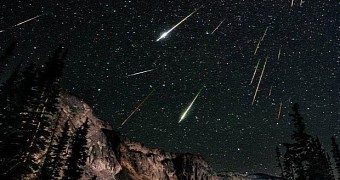This Wednesday, April 22, marks Earth Day, and millions of people all across the globe will gather to celebrate our good old planet and chit chat about how best to protect it.
It just so happens that this Earth Day will end with a cosmic display of fireworks. We're talking about the Lyrid meteor shower that astronomers say will peak in the northern hemisphere between 10:30 p.m. on April 22 and sunrise on April 23.
Folks in the southern hemisphere, on the other hand, will only get to catch a glimpse of Lyrid meteors after midnight, so those of you who live in this part of the planet might want to stock up on coffee.
“Peak rates should occur after 10:30 p.m. on April 22 your local time, for observers in the northern hemisphere. For observers in the southern hemisphere, Lyrid rates are not significant until after midnight your local time,” NASA says.
Word has it that this year's Lyrid shower will birth about 15 to 20 meteors per hour. Provided that the sky is clear and there are no clouds to obscure them, these streaks of light will be clearly visible.
As for having moonlight interfere with the show, astronomers reassure us that this won't happen. Our natural satellite now appears as a thin crescent in the sky, so there is no need to worry about having its glare outshine the meteors.
The Lyrid meteor shower has been happening for millennia
This Wednesday's meteor shower is the result of Earth's passing through debris left behind by Comet C/1861 G1 Thatcher. This happens every year between April 16 and April 26. However, a bonanza of meteors is only visible for a couple of days.
As our planet moves through the debris originating from Comet C/1861 G1 Thatcher, specks of dust coming from this celestial body enter Earth's atmosphere at a speed of about 49 kilometers per second (roughly 30 miles per second) and disintegrate, birthing streaks of light.
Astronomers say that such encounters between our planet and dust from Comet C/1861 G1 Thatcher have been happening for millennia. More precisely, the annual Lyrid meteor shower is estimated to be an impressive 2,600 years old.
Although the event usually sees just 10 to 20 meteors rushing through the sky, it sometimes happens that more comet debris enters our planet's atmosphere and a small army of streaks of light is visible. For instance, sky watchers counted as many as 90 meteors per hour back in 1982.
The reason this annual shower is known as the Lyrids is because, when they form in our planet's atmosphere, the meteors appear to originate from the constellation Lyra.

 14 DAY TRIAL //
14 DAY TRIAL // 